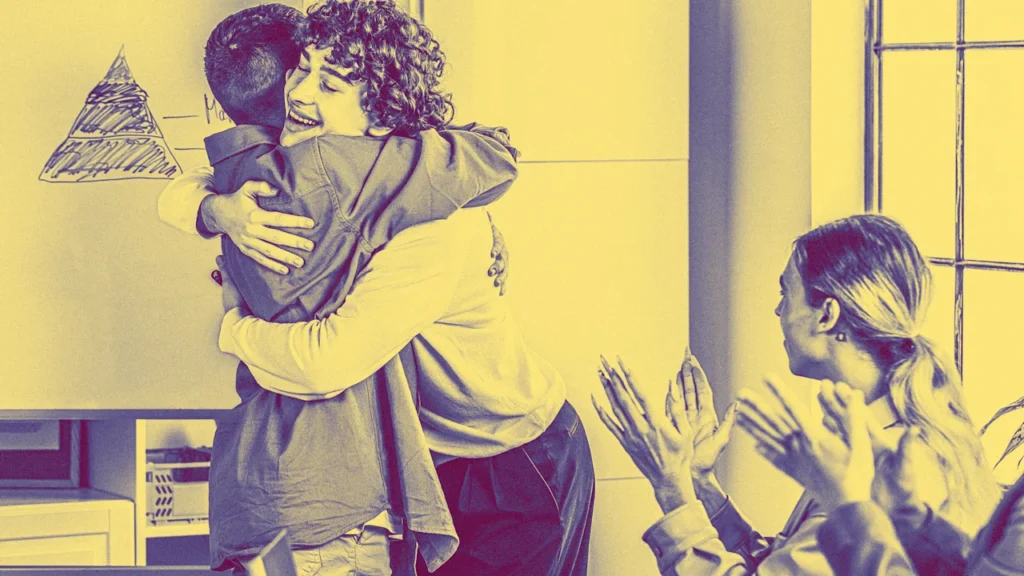
Maybe you’re meeting a coworker you’ve only known on Zoom in person for the first time. Maybe you’re greeting a group of coworkers at a conference, or saying goodbye after a team happy hour. Maybe a coworker has experienced a sudden loss. Or maybe you’re simply more of a hug person than a handshake person.
Is embracing a colleague a faux pas—or worse?
Cultural moments like the #MeToo movement, as well as the hands-off norms established during the pandemic, have shaped opinions about when it’s okay to touch someone else. Although most people don’t greet their office mates with literal open arms each day, colleagues who’ve developed close bonds may feel inclined to hug from time to time.
That’s probably not surprising, given the important role friendships play in the workplace. And with the rise of flexible work in the knowledge economy, where people are encountering colleagues in real life less frequently, interacting with them face-to-face feels more like an event that warrants something more than a firm business handshake.
But is it okay to hug your coworkers? Even if they’re friends? It’s a touchy subject, depending on whom you ask—perhaps the touchiest.
To hug or not hug
Cameron Herold is decidedly pro-hug. The founder of the COO Alliance (a coaching practice for chief operating officers) and former COO of 1-800-GOT-JUNK says he started his career in the straightlaced, suit-and-tie, handshakes-only late ’80s.
A trip to Burning Man in 2007 changed his ways.
“Everybody was hugging. It pulled me way out of my comfort zone,” he says.
Since that trip, he greets just about everyone with an embrace, including former Sprint CEO Marcelo Claure upon meeting him roughly eight years ago.
“I’m 6-foot-3 and he’s 6-foot-7. I went in for an over-the-shoulder hug. He laughed, said that was a first ever,” he recalls. That hug led to two lucrative coaching engagements with Claure and his then-chief operating officer, Herold recalls.
Other workplace experts are more measured about coworkers and touch.
Author and CEO coach Kim Scott, who’s coached at places like Dropbox and Twitter, says if you want to touch someone, it’s your job to find out first whether they’re comfortable being touched. “If they’re not comfortable, don’t touch,” she says, adding, “And if you’re not sure, don’t touch.”
Ignoring that advice could land you in hot water, says Virginia-based employment attorney Leah Stiegler.
She says that legally, there’s a “two-pronged element” to deem an action offensive: The action must be considered offensive by a reasonable third person, in addition to the person touched feeling offended. But if an employee files a lawsuit alleging a hostile workplace or sexual harassment, the company will still have a costly defense on its hands, even if the case is thrown out, Stiegler says.
Plus, even if the hug isn’t something that would rise to the level of a hostile workplace lawsuit, an internal report to human resources about unwanted touching could cause its own problems for the hugger.
When communications adviser Elizabeth Rosenberg worked at a previous employer, part of the company’s (pre-pandemic) annual holiday gathering was having all 300 employees walk the “line of leadership,” where company brass gave each a thank-you note and their bonus. Leaders also gave team members a hug, fist bump, or no touch, depending on the employee’s preference.
Rosenberg says it was up to the team member to voice their preference. “I feel like we have got to be better about taking responsibility for our own feelings,” she says. “If somebody is uncomfortable being hugged, I think they need to step up and say, ‘I’m not comfortable with hugging.’”
Before you reach, read the room
What makes some people open to embracing coworkers while others would rather chew glass? (As one Reddit poster put it: Since when are people giving hugs at work?)
Even outside the office, “hug or no hug” has been a long-standing cultural debate. Social media debates and news articles capture the tension: In general, is hugging creepy? Sweet? Invasive? Affirming? Inappropriate? Appropriate? We all have different backgrounds and preferences that can affect how we feel about being hugged or touched, says workplace mental health expert and licensed clinical social worker Christina Muller.
“Some people call it a ‘love language,’” she says. An individual’s “language” of building connection may be physical touch, like hugging. Others may prefer time spent together, praise, or acts of service, for example. For those people, “getting a cup of coffee or just letting them vent could be a [preferred] source of comfort and connection,” she says.
Even with the risks, Stiegler stops short of recommending a blanket “no hugging/no touching” policy, which she says would be difficult to enforce. Instead, establish strong anti-harassment policies and train employees about the behavior expected in the workplace, including consent.
One solution is to provide an easy way to dodge an unwanted hug, says author Ben Swire, founder of team-building company Make Believe Works. “The offer of a hug should always come with a graceful way out. It shouldn’t feel like, Ooh, if I say no, it’s going to feel weird and icky,” he says. You can literally just ask something along the lines of, “Can I hug you?”
Swire says quickly asking something like, “Are you a hug person, a fist-bump person, or a wave person?” gives people an easy way to choose their comfort level.
Be aware of situational nuances as well, Scott says. In addition to preference and consent, consider whether there are gender or power dynamics in the relationship that could make touch inappropriate. If so, refrain from hugging, she advises. (And if alcohol is involved, it’s a very good idea to stay hands-off, she adds.)
When in doubt, Steigler says, just read the room: “If they’re wearing a COVID mask in 2025, don’t hug them.”